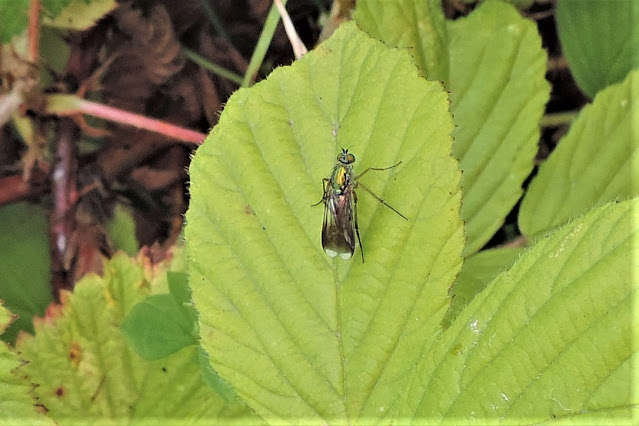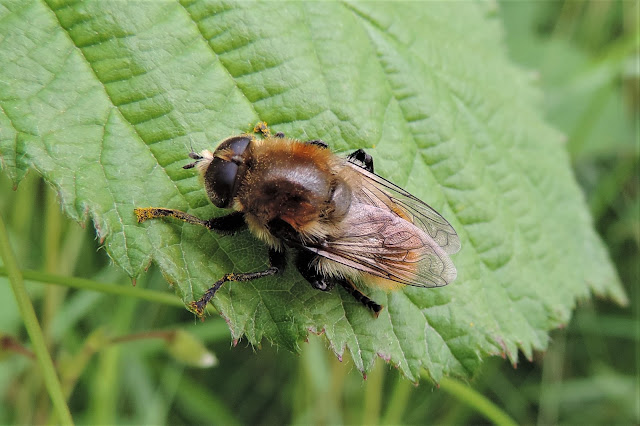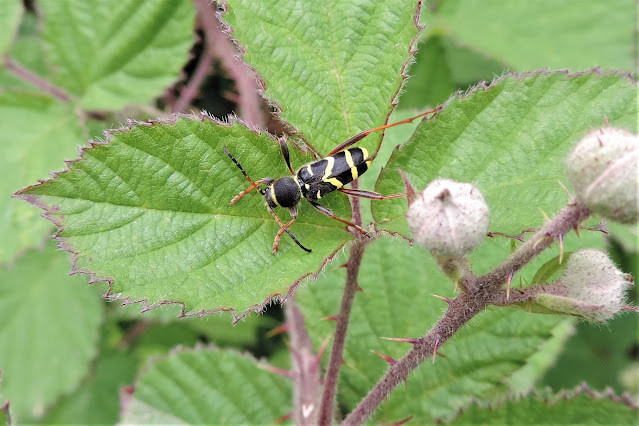The weather has been cloudy with occasional rain and even less sunshine, so hoverfly recording has been difficult over the last few days, with only 25 species recorded over 3 short visits around the valley. A couple of photos of the more colourful observations as well as other insects are below.
Tuesday, 28 June 2022
Poor weather halts hoverfly emergence
Monday, 20 June 2022
Blaencaerau farm
A healthy 37 species of hoverfly seen on my walk today in "not ideal" cloudy conditions New for the year were Platycheirus manicatus, Parasyrphus malinellus, Chrysotoxum festivum, Eupeodes luniger and Scaeva pyrastri. Another 8 Chrysotoxum bicinctum were seen and Eupeodes corollae finally managed double figures for the first time this year. Other highlights were Xanthogramma pedissequum (6), another colour form of Merodon equestris (see below) and 6 Volucella bombylans with two mating.
The Bee Orchid I found last year has flowered again this time with five flowerheads. A Wasp longhorn beetle (Clytus arietus) was new for the site and a Common Lizard was observed giving birth to live young.
Wednesday, 15 June 2022
Caerau livening up
Plenty of hoverflies about today. 33 species in total, new for the year were Scaeva selenitica and Parhelophilus versicolor. A new colour form of Merodon equestris had me going for a while, until I photographed it and plenty of Chrysotoxum bicinctum about, lots of Pipizini on the hemlock water droplet mostly Pipiza austriaca and Pipizella viduata and a few specimens taken that could be better. Still only one Eupeodes corollae about and an interesting Xanthogramma showing characteristics of both pedissequum and stackelbergi taken as a specimen for Roger to sort out.
9 species of day flying moth seen, 5 species of butterfly headed by a very worn Painted Lady.
Saturday, 4 June 2022
Lletty Brongu woods
Warmest day of the year so far at 23c in the afternoon. What seemed like a slow day turned up 26 species of hoverfly. The Hemlock Water-droplet has yet to blossom, only 10% worth so far. The Ground Elder also is only now starting to blossom and numbers of hoverfly per species has yet to peak here. That said new for the year were Orthonevra nobilis (1), Melanogaster hirtella (10), Xylota sylvarum (1) and finally Eristalis arbustorum (1). Chalcosyrphus nemorum seems to be having a good year.
Not much on the bird and insect front except in the first of the year of the longhorn beetle Rutpela maculata and a large emergence of the soldier fly Broad Centurian.
Thursday, 2 June 2022
Caerau old railway line
The old railway line has been made into a public tarred walkway for a number of years now, but is proving a gold-mine for hoverflies, with its rich helping of flora and gets better as the year goes on. Today I recorded 24 species there and new for the year was Chrysotoxum bicinctum (number 73 for the year). The Caerau 1 km square is rapidly heading towards the 100 species mark, now standing at 84.
Wednesday, 1 June 2022
Gilfach (west) [SS8487] - 100 species of hoverfly
Gilfach (west) has become the latest and fourth 1 km square in the valley to reach the 100 species mark following on from Blaencaearu (117), Garnwen (west) (111) and Lletty Brongu woods (102).
Within the square there are multiple habitats including pine forestry, clear-fell, country lanes with large numbers of umbellifers in season, farm fields and mountain moorland. This enables a wide variety of hoverflies to be recorded many of which are either firsts for Wales and Glamorgan or rarities. The elevation is on average 250 metres above sea level but is the first mountain near the coastal region so is a natural gateway to the valley for migrants also.
Recording begins in week 12 (march) where spring hoverflies mass on the over abundance of Sallow blossom. Numbers continue to build to a crescendo at week 26 (late June) when 35 species can be seen in a day. There is a bit of a lull of 2 weeks before the second broods and late summer hoverflies emerge and peak at week 33 (mid-August) with the possibility of 40 species in a day. After that numbers tail off and recording stops at week 37 abruptly because all the flowers have faded and there is no Ivy in the square and hoverflies are easier to find elsewhere in the valley.
Seasonal highlights
Spring - Cheilosia caerulescens, Cheilosia chrysocoma, Ferdinandea cuprea, Sericomyia lappona, Criorhina ranunculi.
Summer - Criorhina ascilica, Xylota tarda, Xanthogramma stackelbergi, Psilota anthracina, Eupeodes lapponicus.
Autumn - Eriozona syrphoides, Eristalis rupium, Rhingia rostrata, Scaeva pyrastri, Scaeva selenitica
hoverflies in red are rare or scarce for Glamorgan or Wales and those in blue are migrants.
Gilfach (west) SS8487
Again only 13 species of hoverfly recorded in what should be ideal weather, maybe the wind is a bit too cold. Highlights included Dasysyrphus pinastri (1), Volucella bombylans (1) and Chalcosyrphus nemorum (4).
Green Tiger beetles are now prevalent as are the longhorn beetles Pachytodes cerambyciformis and Rhagium bifasciatum. There seems to be higher than usual numbers of Dingy Skipper butterflies about this year. I also saw my first Hornet of the year. No birds of note today though.
Juvenile Great Spotted Woodpecker at Cwm Darren woods
An overcast day meant things were poor on the hoverfly front, only 11 species seen. The highlight however was this fearless juvenile Great Spotted Woodpecker that allowed me to within 3 yards of it.
.JPG)
.JPG)


























.JPG)




.JPG)




